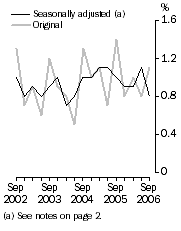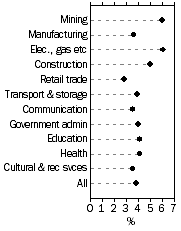PRICE INDEXES AND CONTRACT PRICE INDEXATION
Note: TAKE CARE in using seasonally adjusted and trend estimates. See Explanatory Notes paragraphs 36 to 44.
SEPTEMBER KEY FIGURES
WPI-Quarterly changes, Total hourly rates of pay excluding bonuses

| WPI-Annual change: original, Total hourly rates of pay excluding bonuses - For selected industries

|
SEPTEMBER KEY POINTS
TOTAL HOURLY RATES OF PAY EXCLUDING BONUSES
QUARTERLY CHANGE (JUN QTR 2006 TO SEP QTR 2006)
- The index for all employee jobs in Australia increased by 0.8%, seasonally adjusted.
ANNUAL CHANGE (SEP QTR 2005 TO SEP QTR 2006)
- The seasonally adjusted increase through the year to September 2006 for all employee jobs in Australia was 3.8%.
LABOUR PRICE INDEX EXCLUDING BONUSES
CHANGE FROM 2004-05 TO 2005-06
- The change to 2005-06 was 4.0%, with the private sector increasing by 4.0% and the public sector by 4.4%.
NOTES
FORTHCOMING ISSUES
| ISSUE (QUARTER) | Release Date |
| December 2006 | 21 February 2007 |
| March 2007 | 16 May 2007 |
CHANGES IN THIS ISSUE
Information concerning seasonally adjusted and trend estimates
Care should be taken in using the seasonally adjusted and trend estimates for the wage price index, total hourly rates of pay excluding bonuses shown in Table 1.
With the introduction of WorkChoices, the Australian Industrial Relations Commission's annual Safety Net Review (SNR) of minimum federal award rates has been replaced by determinations by the Australian Fair Pay Commission (AFPC). There was no SNR decision in 2006 and the first AFPC decision will take effect on 1 December 2006. As a result, there have been changes in the size and timing of wage increases reported in the September quarter 2006 as compared to previous September quarters. To account for this, in compiling the seasonally adjusted estimates for September quarter 2006 the ABS has applied both a trend and seasonal break, based on the historical pattern of the impact of the SNR on the WPI. However, it will take some time before the seasonality of the new wage setting mechanisms can be properly determined. This may cause seasonally adjusted estimates to be revised more than usual as additional observations become available.
The cessation of the SNR rulings has resulted in a significant break in the WPI trend series and further shifts in the trend series are expected due to the date of effect of the AFPC decision. ABS has taken the decision to suspend trend estimates until such time as the trend series can be reliably re-established. When trend estimates are re-introduced, it is possible that trend data for the June quarter 2006 and earlier periods will be revised.
For more information, see Explanatory Notes, paragraphs 36-44.
ABS DATA AVAILABLE ON REQUEST
Original indexes are compiled for various combinations of state/territory, sector, broad industry group and broad occupation group. Seasonally adjusted and trend indexes are compiled only for total hourly rates of pay excluding bonuses for each of the private sector, public sector and all sectors. Indexes not included in this publication may be made available on request by telephoning David Taylor on Perth (08) 9360 5151.
FURTHER INFORMATION
More detailed information on the Labour Price Index (LPI) is available in Labour Price Index: Concepts, Sources and Methods, Australia (cat. no. 6351.0.55.001).
INQUIRIES
For further information about these and related statistics, contact the National Information and Referral Service on 1300 135 070 or David Taylor on Perth (08) 9360 5151.
COMMENTARY
WAGE PRICE INDEX
National minimum award wage increases
Each year since the inception of the Labour Price Index Survey, the Australian Industrial Relations Commission (AIRC) has conducted a Safety Net Review (SNR) which set federal full-time minimum award rates. Historically, the SNR had most of its impact on the wage price index in the September and December quarters. As a result of industrial relations changes associated with WorkChoices, the AIRC did not undertake a review during 2006. From this year the Australian Fair Pay Commission (AFPC) has responsibility for setting federal minimum award rates.
In the absence of a 2006 SNR and prior to the AFPC ruling on 26 October 2006, the State Industrial Relations Commissions in New South Wales, Queensland, South Australia, Western Australia and Tasmania announced changes in minimum wages for state based awards. These State determinations were reported by some employers as a factor in wage increases in the September quarter 2006 but they affected very few jobs and had minimal impact on the wage price index.
The AFPC's ruling on federal minimum award rates has a date of effect of 1 December 2006. The impact on the wage price index of the first AFPC ruling is expected to occur mainly in the March and June quarters of 2007.
For information about how industrial relations changes have affected the seasonally adjusted and trend estimates, see paragraphs 36-44 of the Explanatory Notes.
Industry
In original terms, the industries with the highest rate of increase through the year to September quarter 2006 were Electricity, gas and water (6.1%), Mining (6.0%) and Construction (5.0%). The lowest rates of increase were reported in the Retail and Accommodation, cafes and restaurants industries (2.8% and 2.4% respectively).
NON-WAGE PRICE INDEXES
Annual and public holiday leave
There were no changes in public holiday entitlements between 2004-05 and 2005-06 in any State or Territory and minimal changes reported in annual leave entitlements. As a result, the movements of this index for 2005-06 reflect the impact of increases in wages and salaries.
Superannuation
The percentage change from the previous financial year increased from 4.0% in 2004-05 to 4.2% in 2005-06. This increase was mainly driven by rises in wages and salaries with few jobs recording a change in the rate of superannuation.
Payroll tax
With the exception of the Northern Territory (NT), payroll tax thresholds and rates were unchanged from 2004-05 to 2005-06. Higher wages growth in 2005-06 compared to 2004-05 has led to the payroll tax index recording a higher increase for 2005-06 than for the previous year (4.1% compared to 3.8%).
In the NT the payroll tax threshold was increased from $800,000 to $1,000,000 from 1 July 2005. However, the payroll tax rate was left unchanged. This resulted in a decrease of 4.0% in 2005-2006 in the private sector payroll tax index for the NT.
Workers' compensation
While some jurisdictions reduced premium rates as part of continued scheme redesigns, wages growth during 2005-06 resulted in a 1.3% increase overall from the previous financial year. The movements for individual jurisdictions are varied and reflect modifications to workers' compensation schemes and wages growth.
 Print Page
Print Page
 Print All
Print All